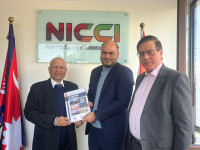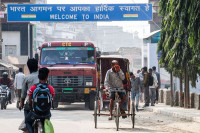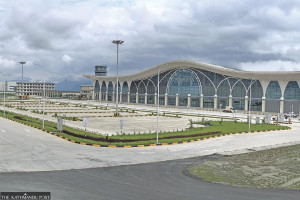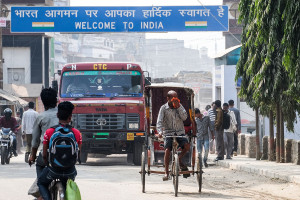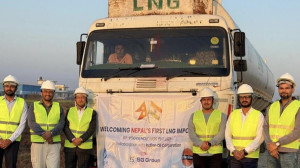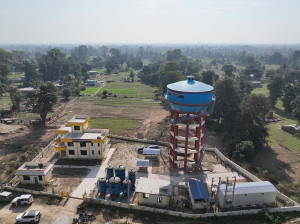Money
Tourist city rises as trade, industrial hub
Better known as a tourist destination, Pokhara has now emerged as a center of trade too.
Ishwori Neupane
Better known as a tourist destination, Pokhara has now emerged as a center of trade too. Swelling economic activities have resulted in an increase in income; and Kaski district, where the lakeside city is situated, is considered to have one of the lowest poverty rates.
As per a report of the Central Bureau of Statistics, Pokhara Sub-Metropolitan City is one of the more properous towns in the country. The report shows that the city, which does not have a long history of being inhabited, is now rising in terms of economic development.
Ananda Raj Mulmi, former president of the Federation of Nepalese Chambers of Commerce and Industry, said the city was developing at a faster pace compared to similar other cities which have a long history of settlement. “Day by day, it is becoming a hub for almost every activity.”
In recent days, there has been a massive growth in entrepreneurship in Pokhara. According to the Inland Revenue Office (IRO), there are over 48,000 entrepreneurs in the area. Jagadishwor Upadhyay, chief tax officer at the IRO, said Pokhara was one of the highset tax paying cities in the country. “IRO Pokhara is just behind IRO Lalitpur out of the 21 IROs in the country with regard to contributing taxes to the govenrment,” he said.
A total of Rs 1.33 billion was collected in tax revenue from IRO Pokhara in the last fiscal year. “Based on the revenue collection, Pokhara seems to be experiencing a substantial growth in the business activities,” said Upadhyaya.
The per capita income of the entire Kaski district has become one of the highest in the country due to increasing entrepreneurship mainly among the middle income group.
There are thousands of small factories operating in the region. Kaski is one of the districts having the largest number of enterprises. According to the Department of Industry, a total of 244 factories with each having a capital investment of more than Rs 30 million have received operating licences from it.
Although there are no large production plants like in the Tarai region, the attraction for operating small scale plants is on a rising trend. An estimated Rs 41.60 billion has been invested in these factories.
Apart from local investors, Pokhara has been increasingly attracting the interest of foreign investors. According to the department’s records, a total of Rs 10.44 billion in foreign investment has been poured into 163 production plants here. The production units established by domestic and foreign investors provide direct employment to 22,742 persons.
Besides, a large number of medium sized industries along with hotels and restaurants are also operating here. Hari Sharma, president of the Pashchimanchal Hotel Association, said the tourism sector here had an investment base of more than Rs 60 billion and employs 50,000 persons.
Although there are no large manufacturing plants installed here, the service sector in particular is booming. According to Mulmi, the increasing business potential here is attracting even infrastructure development. “With flourishing business activities and growing infrastructure, Pokhara is turning into a centre of economic development of the country.”
Based on the thriving development, Pokhara may not seem to be limited as a hub for the Western Region only. The potential for road network development is another vital issue of the region. The short road link from Khairenitar of Prithvi Highway that connects the Tarai and the Indian border through Bhimad-Keladighat and the Arun River is another milestone for business growth in the region. The road which is under construction is expected to be completed by the end of this fiscal year.
If a bridge is constructed across the Kali Gandaki River at Keladighat, the road distance to Mugling from Pokhara will be shortened by 67 km. “Even when the current single lane road along the Khairenitar-Arun River section is expanded, much business potential will arise as it will give the region easy access to the Tarai as well as the Indian border,” said Mulmi.
In addition, the region has equal potential of being connected to the Chinese border through Mustang and Rasuwa districts. The government has already allocated land for a proposed special economic zone in Syafrubesi, Rasuwa. Similarly, the Chinese government has also been eyeing expanding the customs point there. Likewise, a feasibility survey is also going on to construct a mid-hill highway from Trishuli-Gorkha to connect Begnas Lake of Pokhara. Provided the infrastructure is built, Pokhara will have a short access to even the Chinese border.
The Pokhara-Jomsom-Ghoktang route is yet another potential road for the region to connect to Chinese territory. The distance over the route is a mere 256 km from Pokhara. Lomanthang of Jomsom district is connected by road from both Pokhara and the northern neighbour. The road connection from Jomsom to Lomanthang, which cannot be operated during the rainy season, can be brought into use throughout the year if a few bridges are constructed. The region has become a centre of attraction for both Indian and Chinese tourists. After the construction of roads and the proposed international airport, a greater number of visitors could be attracted from both the neighbouring countries.
Gorakh Raj Ojha, a professor of economics at Prithvi Narayan Campus, said Pokhara would have to focus on expanding its capacity of accomodating more people. “The area could be developed as the business hub for both the neighbouring countries.” He stressed the need for political consensus to promote local products having high export potential.
Amid the immense potential, the region is seeing increasing infrastructure development too. Constructing a regional international airport is getting delayed although it is in the govenrment priority list while a 82-km ring road has also been proposed in the city.
According to the Division Road Office, six highways connecting two districts from Pokhara are being constructed. Similarly, construction of another 22 roads to connect the economic centers of the city are also under construction. “These roads have been planned to be blacktopped by 2020,” said Bishwa Bijaylal Shrestha, an engineer at the division office.
Narayan Prasad Shrestha, chief of the Technician Office and a district engineer, said 61 roads with a total length of 1,000 km are under construction throughout the district. In addition, construction of two cable cars connecting Shanti Stupa and Sarangkot is underway.
The region is also considered to have good hydropower potential. About 50 percent of the 758 MW of hydropower produced in the country comes form the region. Similarly, it accounts for an additional 1,000 MW of hydroelectricity out of the 1,900 MW from proposed projects.
Recently, an Indian company conducted a feasibility survey to build a Kathmandu-Pokhara railway service. “The project could be turned into reality if the volume of transactions and people’s movement in the region increase,” said Tulsi Sitaula, secretary at the Ministry of Physical Planning and Constuction.




 14.12°C Kathmandu
14.12°C Kathmandu

